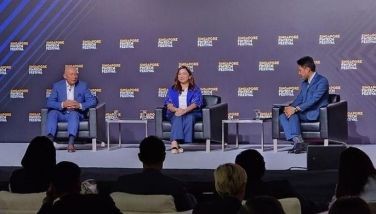Nokia evolves for next billion customers
June 24, 2006 | 12:00am
By 2008, there will be three billion mobile subscribers in the world and Nokia, the current leading handset maker, wants a lion share of it.
As of September 2005, the global market stands at two billion mobile subscribers. Around that time Nokia said it was able to sell a billion handsets.
Market pundits believe that majority of the next billion mobile subscribers will come from countries like Africa, India, China and the Middle East. For Nokia, the Asia-Pacific will be a major growth area with India poised to be its second biggest market after China.
"The Asia-Pacific has 20 percent share of our volume business, making it the second biggest market for the company. The growth markets here are India, Bangladesh, Indonesia, and Vietnam," said Urpo Karjalainen, senior vice president for customer and market operations of Nokia, APAC.
To get a better grip of the next billion mobile consumers, Nokia announced this week in Singapore that it is changing its product categories into four new areas – Live, Connect, Achieve, and Explore. With this category renewal, the company believes it can better offer the right set of features, cost and form factor to specific consumer groups.
Using the new product categories, Nokia expects the next billion customers to fall under the Live and Connect segments.
"The category renewal will show how Nokia will approach the market to get to the next billion customers. Live is for those who go for design and style, Connect is those who want for simple connectivity only," said Robert Andersson, Nokia executive vice president for customer and market operations.
Achieve is a category that describes those who want collaboration tools in their handsets, while Explore targets users who go for high-end units such as the Nokia 92.
The category renewal is the result of an extensive survey participated in by 42,000 consumers in 16 countries. Andersson said it’s the largest and most compelling research done in the mobile industry to date that equals 13 years of uninterrupted 24 x 7 interviews.
"In that study we saw the socio-economic dynamics and expectations of customers which strongly suggest that one size doesn’t fit all," Andersson added.
Because of the survey, Nokia has identified 11 unique segments to serve all types of consumers common to all markets across the world, each looking for specific sets of features in their handsets.
"The result is one Nokia, four categories and two sub-brands: the Nseries multimedia phones and the E-series business-enhanced phones. We want to be the world’s most respected brand. It’s no small task and our category renewal is a move toward this direction," said Andersson.
The next billion customers will be from low-income groups with salaries of only $50 to $100 a month, said Soren Petersen, Nokia’s senior vice president for entry business unit mobile phones.
"For this market, Nokia’s value proposition is affordable connectivity. It’s not just about developing cheap models as if to say: ‘To you poor people we will give cheap phones.’ It doesn’t work that way," stressed Petersen.
For the last two decades, Nokia has been trying to reduce the cost of handsets, said Petersen, by looking at different areas of TCO (total cost of ownership).
Citing a study made by the Global Mobile Suppliers Association last September, Petersen said a mobile subscriber normally spends 17 percent for the service, 15 percent for taxes, and 14 percent for the handset. Bringing the TCO down will be the true driver of mobile penetration, he added.
"We should look at reducing cost to sell while increasing revenues or reducing cost to carry and the cost to serve. Operators in low-income countries are doing some of these but they should do it more constantly across their markets," Petersen said.
To make a mobile service sustainable for those in the low-income group, the study determined that the total cost should not be more than $5 a month which translates to only P266.
"Those in low-income groups can only spend 10 to 15 percent of their income for mobility, or at least $5 a month. So when we look at what is the sustainable business for this market, it all comes down to this $5 monthly budget," Petersen said.
With its thrust to bring affordable connectivity, Nokia this week launched its most affordable 3G handset to date, the Nokia 6151.
The Nokia 6151 is the company’s latest attempt to make 3G accessible to all people. It is expected to begin shipping in the third quarter with a price tag of 240 euros or P16,085.
Aside from 3G capabilities, the Nokia 6151 has a 1.3-megapixel camera, 30MB user memory, music player, stereo FM and Visual Radio, Bluetooth wireless connectivity and Push to talk.
To date, there are 800 million Nokia users and over half of them are connected via operator-deployed Nokia networks.
As of September 2005, the global market stands at two billion mobile subscribers. Around that time Nokia said it was able to sell a billion handsets.
Market pundits believe that majority of the next billion mobile subscribers will come from countries like Africa, India, China and the Middle East. For Nokia, the Asia-Pacific will be a major growth area with India poised to be its second biggest market after China.
"The Asia-Pacific has 20 percent share of our volume business, making it the second biggest market for the company. The growth markets here are India, Bangladesh, Indonesia, and Vietnam," said Urpo Karjalainen, senior vice president for customer and market operations of Nokia, APAC.
To get a better grip of the next billion mobile consumers, Nokia announced this week in Singapore that it is changing its product categories into four new areas – Live, Connect, Achieve, and Explore. With this category renewal, the company believes it can better offer the right set of features, cost and form factor to specific consumer groups.
Using the new product categories, Nokia expects the next billion customers to fall under the Live and Connect segments.
"The category renewal will show how Nokia will approach the market to get to the next billion customers. Live is for those who go for design and style, Connect is those who want for simple connectivity only," said Robert Andersson, Nokia executive vice president for customer and market operations.
Achieve is a category that describes those who want collaboration tools in their handsets, while Explore targets users who go for high-end units such as the Nokia 92.
The category renewal is the result of an extensive survey participated in by 42,000 consumers in 16 countries. Andersson said it’s the largest and most compelling research done in the mobile industry to date that equals 13 years of uninterrupted 24 x 7 interviews.
"In that study we saw the socio-economic dynamics and expectations of customers which strongly suggest that one size doesn’t fit all," Andersson added.
Because of the survey, Nokia has identified 11 unique segments to serve all types of consumers common to all markets across the world, each looking for specific sets of features in their handsets.
"The result is one Nokia, four categories and two sub-brands: the Nseries multimedia phones and the E-series business-enhanced phones. We want to be the world’s most respected brand. It’s no small task and our category renewal is a move toward this direction," said Andersson.
"For this market, Nokia’s value proposition is affordable connectivity. It’s not just about developing cheap models as if to say: ‘To you poor people we will give cheap phones.’ It doesn’t work that way," stressed Petersen.
For the last two decades, Nokia has been trying to reduce the cost of handsets, said Petersen, by looking at different areas of TCO (total cost of ownership).
Citing a study made by the Global Mobile Suppliers Association last September, Petersen said a mobile subscriber normally spends 17 percent for the service, 15 percent for taxes, and 14 percent for the handset. Bringing the TCO down will be the true driver of mobile penetration, he added.
"We should look at reducing cost to sell while increasing revenues or reducing cost to carry and the cost to serve. Operators in low-income countries are doing some of these but they should do it more constantly across their markets," Petersen said.
To make a mobile service sustainable for those in the low-income group, the study determined that the total cost should not be more than $5 a month which translates to only P266.
"Those in low-income groups can only spend 10 to 15 percent of their income for mobility, or at least $5 a month. So when we look at what is the sustainable business for this market, it all comes down to this $5 monthly budget," Petersen said.
With its thrust to bring affordable connectivity, Nokia this week launched its most affordable 3G handset to date, the Nokia 6151.
The Nokia 6151 is the company’s latest attempt to make 3G accessible to all people. It is expected to begin shipping in the third quarter with a price tag of 240 euros or P16,085.
Aside from 3G capabilities, the Nokia 6151 has a 1.3-megapixel camera, 30MB user memory, music player, stereo FM and Visual Radio, Bluetooth wireless connectivity and Push to talk.
To date, there are 800 million Nokia users and over half of them are connected via operator-deployed Nokia networks.
BrandSpace Articles
<
>
- Latest
Latest
Latest
February 22, 2024 - 3:17pm
February 22, 2024 - 3:17pm
December 28, 2023 - 12:00am
December 28, 2023 - 12:00am
December 11, 2023 - 11:00am
December 11, 2023 - 11:00am
November 23, 2023 - 4:35pm
November 23, 2023 - 4:35pm
October 16, 2023 - 5:00pm
October 16, 2023 - 5:00pm
Recommended






























